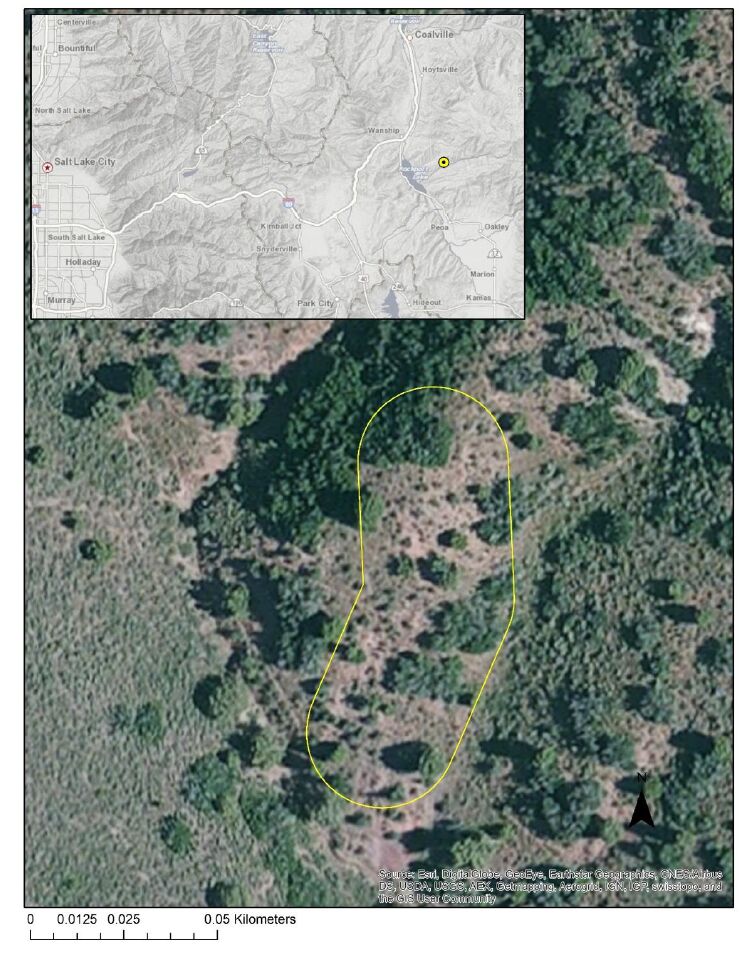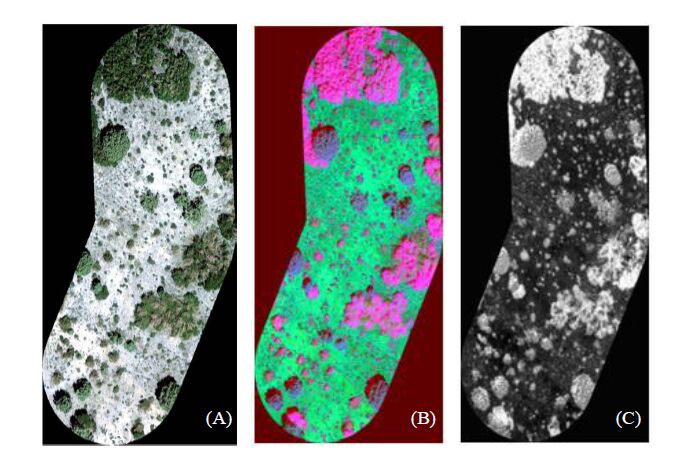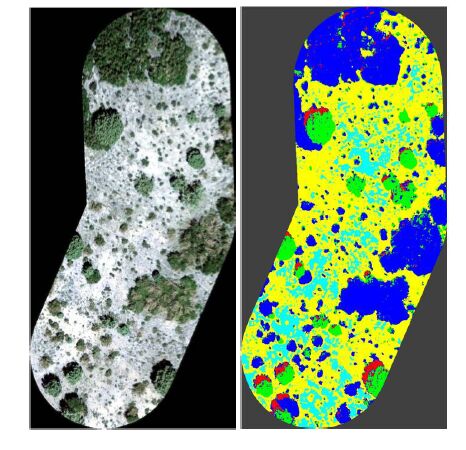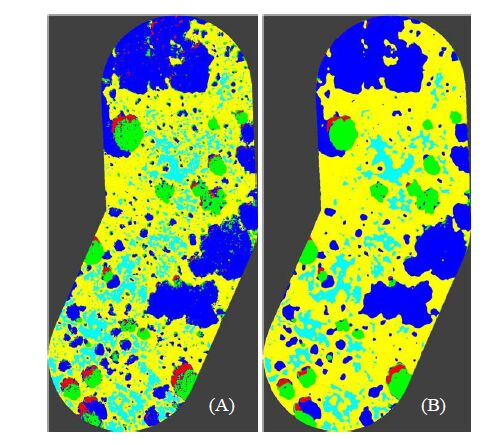1. Introduction
Rangeland monitoring techniques have been developed to quantify, evaluate, and monitor semi-arid plant communities, particularly where multiple-use land management practices require adaptive management strategies. By definition, rangeland monitoring is the gathering of basic ecological information that describes rangeland attributes using systematic and repeatable methods [1]. An understanding of rangeland attributes can be used to better understand range condition or the current state of rangeland health and trend over time [2]. Information derived from rangeland monitoring can also be used to track the progress of range improvement projects, to determine the efficacy of particular management practices, and to assess seed germination and establishment that leads to greaterforage production and higher plant biodiversity [3,4]. Rangeland trend and monitoring can be used to characterize ecological succession, in particular states and transitions within a state-and-transition conceptual framework, to identify potential impacts from invasive species, assess disturbance patterns from fire, and characterize ecological resilience following disturbance [5,6,7].
Of the vegetation attributes measured using rangeland monitoring practices, the most meaningful, adequate, and economically efficient methods are percent canopy (ground) cover and percent bare ground [8,9]. The primary reason that cover plays such an important role in rangeland monitoring is that these attributes have a direct relationship to plant community resilience, soil stability, and soil conservation [10,11]. Fox et al. [12] found that raindrop impact on exposed bare ground can dislodge soil particles which may transform the soil surface and reduce infiltration. Intact plant communities that maintain high plant cover of perennial species may increase ecological resilience and resistance to both natural and human-related disturbance [13]. Similarly, perennial plant cover can reduce the invasibility of rangeland ecosystems by species such as cheatgrass (Bromus tectorum) [14]. Ground cover by vegetation and litter and its inverse of bare ground become important attributes in assessing hydrologic function and need for soil conservation practices, and is a good indicator of vegetative dominance and relative resource use in a community [15].
In the state of Utah, the Division of Wildlife Resources Big Game Range Trend Study Program (UDWR RTP) was established during the early 1980s to monitor, evaluate, and report range trend at key areas throughout the state. Study plots are sampled once every five years to determine vegetation condition and trend assessment in relation to land management treatments such as chaining, fire, disking, and herbicide application. The UDWR selects these sites primarily based on areas of critical winter (and in some cases spring and or summer) range for deer (Odocoileus hemionus) and elk (Cervus canadensis) [16]. These data are intended to provide biologists, land managers, and private landowners with information describingsignificant changes in plant community composition, for assessing project success and vegetation response to range treatments, and for monitoring ecological succession [16]. Each year UDWR field crews collect range inventory data in one of five regions to determine range condition and trends for those sites. Because the UDWR has an archive of each site dating back to the beginning of the project, these data can be used to compare range conditions for identifying past and current condition and trend (i.e., upward, downward, stable) [16].
Ground cover is one of the key indicators of rangeland health as it provides information pertaining to ecological processes (i.e., nitrogen cycling, rainfall infiltration potential), erosion, wildlife habitat, and forage availability [17,18,19]. Though cover is a key indicator used in trend programs, traditional methods are costly in time and resources which can lead to fewer data and less accurate estimates [20]. Additionally, ground cover can be assessed using a wide variety of methods, making it difficult to standardize for comparison across space and time [3]. The efficiency of the cover method chosen is crucial due to the large spatial and temporal scales involved in rangeland monitoring; the more accurate and precise methods are complex in nature and typically require significant time and funding commitments [21]. Therefore, ground cover methods utilized are those in which a certain level of accuracy and precision (repeatability) can be achieved at a certain cost [3]. Because of these limitations, managers need new methods that are rapid, accurate, cost-effective, and robust for monitoring range health and trend [18,22,23].
Remote sensing can offer a rapid method for effectively and efficiently detecting vegetation cover with an acceptable level of error [17,24,25]. There is evidence that remote sensing may prove superior to conventional ground measurement methods for several reasons: (1) it facilitates extensive data collection by reducing the labor requirement for monitoring, (2) it reduces human bias by limiting the influence of human judgment, (3) it is more precise, and (4) it provides a permanent record of information that can be retained for future scrutiny [17]. The purpose of this study was to test the efficacy of remote sensing as a surrogate for field-based sampling techniques in detecting and quantifying ground cover features (i.e., trees, shrubs, herbaceous cover, litter, bare ground). These data were compared with field-based ground cover measurements collected by the UDWR RTP. Additionally, this research provides an evaluation of remote sensing as a simple and practical approach that can be used by agencies with minimaltraining and expertise in geographic information system (GIS) and remote sensing.
2. Methods
2.1. Study site description
Each year UDWR field crews survey approximately 100 key sites within one of Utah's five regions (Figure 1). Sample sites were chosen using 2011 UDWR RTP (Northern Region of Utah) monitoring sites. Since range trend sites are selected using statewide vegetation type data, we used this same classification to select a subset from the UDWR RTP sites to estimate ground cover remotely. When examining the vegetation layer, three vegetation types (Wyoming big sagebrush [Artemisia tridentata ssp. wyomingensis], mountain big sagebrush [Artemisia tridentata ssp. vaseyana], and mountain brush [a mixture of mountain shrub species]) represented a land cover type that would be adequately replicated to meet statistical rigor. The coordinate locations of all 71 RTP sites were imported into ArcGIS from which 40 were randomly selected (Figure 1).
2.2. Ground measurements
Percent cover that was measured from ground-based sampling techniques was collected by the UDWR Range Trend Program crews at each study site location using the Range Trend protocol [16]. Data were collected from five 30.48 m (100 ft) sections (a total of a 152.4 m (500 ft) baseline). Within each section a continuous distance mark was identified (i.e., 3.35 m (11 ft); 40.84 m (134 ft); etc.) was chosen and another 30.48 m transect was laid perpendicular to the baseline at that point. The 30.48 m perpendicular transect was centered at the random distance mark with 15.24 m (50 ft) on each side of the baseline (Figure 2) [16]. Herbaceous vegetation, litter, and bare ground percent cover data were collected along each transect using a modified Daubenmire ocular estimate procedure. The line intercept method was used to measure tree and shrub ground cover. Using the Daubenmire ocular estimate, 0.25 m2 quadrats were placed every 1.5 m along the graduated side of the transect, starting at the 1.5 m mark for a total of 20 quadrats per transect [16]. Cover for each species, litter, and bare ground were estimated in each quadrat using 7 cover classes: (1) 0.01-1%, (2) 1.1-5%, (3) 5.1-25%, (4) 25.1-50%, (5) 50.1-75%, (6) 75.1-95%, and (7) 95.1-100%. Average cover was calculated for each transect. The average of the five belts provided anaverage percent cover value attributed to each site.
The line intercept method used to estimate tree and shrub cover was adopted from a U.S. Bureau of Land Management sampling protocol. Along each transect, the distance intersected by species was measured and divided by the total length of the transect to provide percent canopy cover [16]. The UDWR modified the line intercept sampling protocol to measure all potential cover classes (tree, shrub, herbaceous, surface; Table 1). This made it possible for us to compare potential differences between field-based and remotely-sensed methods.
Table 1. Cover classes and descriptions used in this study.
| Cover Class |
Description |
| Tree |
Primarily juniper (Juniperus osteosperma and Juniperus occidentalis) and pinyon pine (Pinus edulis). On one site maple (Acer grandidentatum) was present. |
| Shrub |
Dominant shrub cover included sagebrush (Artemisia tridentata), snowberry (Symphoricorpos occidentalis), serviceberry (Amelanchier alnifolia), antelope bitterbrush (Purshia tridentata), green rabbitbrush (Chrysothamnus viscidiflorus), and rubber rabbitbrush (Ericameria nauseosa) |
| Herbaceous |
Mix of perennial grass, annual grass, forb, and small shrub species. |
| Surface |
Rock, gravel, and bareground |
Since multiple layer sampling was used in the collection of ground-based cover values, it became theoretically possible to produce cover estimates equal to or greater than 100%. To account for this, percent cover estimates made by field crews using the line intercept protocol were compared to the original protocol (quadrats for herbaceous and surface estimates, and line intercept for tree and shrub) using a paired t-test (significance level of p < 0.05). This made it possible to compare methods and determine if results were similar or dissimilar, in particular for surface features. It was determined from the analysis that all functional groups (except for surface) did not differ from each other in percent cover estimates (tree P = 0.36, shrub P = 0.38, herbaceous P = 0.33, surface P < 0.001, N = 16). Although methods differed for the surface class, it was not necessary to normalize or transform the UDWR estimates since these differences were a response of sampling method. Subsequently, UDWR Range Trend estimates were used as reported originally.
2.3. Image acquisition and preprocessing
Four-band red, green, blue, and near infrared images were acquired by Aero-Graphics Inc., Salt Lake City, Utah, in July, September and October of 2011 (Figure 1). The camera used throughout this study was an UltraCam X (UCX) digital camera (Vexcel Imaging GmbH, Graz, Austria), carried on-board a Piper PA-46 Malibu at a maximum cruise speed of 213 knots. Imagery was acquired at an average altitude of 833.6 m above ground level, producing images with 25 cm pixel resolution. The average extent of the images within the plot boundaries was approximately 152 m in length and 30 m in width. A total of 10 images were collected at each location and then radiometrically corrected and balanced. The UCX is equipped with a precision Global Positioning System (GPS) and Inertial Measurement Unit (IMU) which were used to geometrically correct images within ±1.5 m accuracy of true horizontal position. The UCX was also equipped with Forward Motion Compensation and was mounted in a GSM-3000 gyro-stabilized mount that works with the IMU to automatically correct up to 5° roll, 8.4° pitch, and 6.2° yaw prior to each exposure being fired. Continuously Operating Reference Stations (CORS) were used to ensure that the image data maintained it's true geographic integrity with a known estimated error. SmartBase solutions were used to differentially correct the aircraft's trajectory data. Imagery was projected in UTM Zone 12 and used NAVD88 as the vertical datum and NAD83 as the horizontal datum. Due to an unforeseen circumstance the contractor's server crashed prior to relaying all of the imagery and four images were never recovered, bringing our total site count down to 36.
2.4. Image classification and processing
Images were classified by assigning each pixel a discrete vegetation, litter, or bare ground cover class. An unsupervised and supervised image classification approach are both commonly used to create vegetation and bare soil classes [26,27]. Using ENVI 5.0 Feature Extraction software, an unsupervised classification was first performed on a subsample of the sites. This classification provided a useful general assessment of cover class patterns, but was inadequate for an accurate classification of different vegetation types. Using the supervised classification approach, a training set was established using the "polygon" method by drawing polygons around areas representing a particular cover class [26]. A minimum of 250 pixels were used to produce the training set for each cover class. These training sets were created across the entire image thereby including as much variation in pixel value by cover class type as possible. The total number of pixels per training set for each cover class ranged between 30-1000 pixels.
Areas to be included in the training sets were determined from a combination of photos taken from the field by the UDWR range trend crew, true color aerial images, a tasseled cap transformation (compares differences in vegetation, soil, and anthropogenic features over short and long-term time periods in an image), and a Normalized Difference Vegetation Index (NDVI; a measure of greenness in plants). An example is provided for a plot located in Crandall Canyon, Utah (Figure 3) with true color, tasseled cap transformation, and NDVI transformation (Figure 4). Training sets were then used to classify the entire image using a maximum likelihood supervised classification (Figure 5). A 7 × 7 lowpass filter was applied to each supervised classification to reduce pixilation in effort to improve classification accuracy (Figure 6). Classified images were generally inspected for accuracy before proceeding. If the classifications failed to represent what was in the image, additional training sets for a particular class were added.
During the classification process, we noted several images that were blurred during image acquisition or had significant shadow that reduced image quality and classification reliability. Subsequently, these images were considered unsuitable for accurately assessing cover classes, and were removed from the analysis. This reduced the initial total of 36 sets to 26 that were able to be classified.
2.5. Accuracy assessment and statistical analysis
The accuracy in detecting cover was assessed using ERDAS Imagine® software (Intergraph Corp., Madison, Alabama). Each cover class was assigned ≥35 random points using a stratified random approach [28]. This was repeated on all 26 sites analyzed in this study (N = 3297 points, Table 2). To validate the accuracy of the image classification, we visually distinguished the cover classes using 0.06 m true color imagery downloaded from Utah's Automated Geographic Reference Center. A confusion matrix was produced summarizing all tabular output data from ERDAS rendering a table showing how the random points within each class were classified, the producer's and user's accuracies, overall accuracy, overall kappa statistic, and conditional kappa statistics for each cover class [29]. We used program R to analyze differences between mean tree, shrub, herbaceous, and surface cover from remotely sensed images and field based samples using a paired t-test (P < 0.05) for each cover class. The assumptions for a t-test were met (normality and homogeneity).
Table 2. Comparison of mean percent cover estimates between remotely-sensed and field-based data using a paired t-test (N = 18 sites).
|
Mean Difference |
| Cover Class |
p-value |
(%Cover) |
95% CI (% Cover) |
| Tree |
0.6517 |
0.26 |
−0.94-1.46 |
| Shrub |
0.8004 |
0.41 |
−3.75-2.93 |
| Herbaceous |
0.2576 |
5.61 |
−4.49-15.71 |
| Surface |
5.80E-08 |
26.86 |
20.65-33.07 |
3. Results and Discussion
Statistical tests of the classified images show the agreement between ground reference data and remotely-sensed estimates to be "almost perfect" according to Landis and Koch measure of agreement [30], where overall accuracy across all sites was 91%, with an overall Kappa statistic of 0.88 (Table 3). Interestingly, the results from the Conditional Kappa statistics (for each category) were opposite those from the paired t-test; in that the highest level of agreement was among the surface class and lowest among tree cover although all classes were shown to be in agreement according to the Conditional Kappa (measurements of agreement, producers and users accuracies compare classified images to reference images). We found that each cover class was most often misrepresented by pixels near the edge of the class either in the above and/or below strata (i.e., shrub cover was most often misrepresented to be either tree or herbaceous cover). This can be attributed to less dense foliage and more or less light reflectance near the edge of a particular class [31].
There was no statistical difference between remotely-sensed and field-sampled estimatesfor tree, shrub, and herbaceous cover (Table 3). Mean values between remotely-sensed cover and field data was different by 0.26% (0.95-1.21%). Differences in shrub and herbaceous canopy cover were 0.41% (22.50-22.91%) and 5.61% (66.85-72.46%), respectively. The surface cover class was shown to be significantly different with a P < 0.001, and was underestimated by remote sensing by an average of 26.9% (5.50-32.4%). These differences are likely due to the difference in methods where the UDWR RTP protocol is designed to measure bare ground where bare ground below vegetation cover is included in the total surface value. Vegetation monitoring is necessary for accurately assessing plant community structure, rangeland productivity and health, and plant community succession [32,33]. Both field-based measurements and remotely-sensed information provides insight into these important functions and have proven to be effective methods in gathering data used to assess these different ecosystem processes [3,20].
High resolution remote sensing provides an effective tool for quantifying surface features that predict and assess primary ecological processes. In this study, high resolution RGB images provided cover estimates that did not differ (p < 0.05) from field-based estimates, with a 91% overall accuracy when classifying total plant cover. Remote sensing can be effectively used to classify vegetation using spectral classification techniques. Booth et al. [34] among others [35,36] found that image analysis cover estimates were not significantly different from field-based measurements and could be done in a fraction of the time. Booth et al. [9] found that although ground measurements are sometimes considered to be more accurate, the overall accuracy of an assessment can be called into question when there are constraints such as time and seasonal demands, cost, and sample size. The ability to capture images and analyze them at a later date, which is typical of remote sensing, can address these concerns [9]. Fewer time constraints combined with greater spatial and temporal extent would allow land managers that use remote sensing to make more effective and efficient management plans at the landscape level as long as imagery is high quality and cover classes are broad.
Table 3. Confusion Matrix Showing Classification Accuracy across all Sites.
| Cover Class |
Tree |
Shrub |
Herbaceous |
Surface
|
| Tree |
302 |
47 |
17 |
1
|
| Shrub |
20 |
817 |
51 |
2
|
| Herbaceous |
1 |
47 |
1196 |
47
|
| Surface |
0 |
0 |
57 |
692
|
| |
|
|
|
|
| Producers Accuracy (%) |
93 |
90 |
91 |
93
|
| Users Accuracy (%) |
82 |
92 |
93 |
92
|
| Conditional Khat |
0.80 |
0.89 |
0.88 |
0.9
|
| Overall Accuracy = 91%, Khat = 0.88, N = 3297
|
Khat = coefficient of Agreement (Kappa Statistic); N = number of points evaluated
Underlined values indicate correct number of points classified within a cover class |
Based on the results of this study, an advantage of using remote sensing for collecting vegetation measurements is that imagery can help identify vegetation (by functional group) and surface structure and patchiness. These data could then be used to provide insight into plant species longevity (i.e., invasion by cheatgrass) and to quantify the juxtaposition of plant communities with surface feature classes for predicting ecological processes and site resilience. This knowledge could allow managers to assess potential risks of soil erosion, and employ management methods in areas of highest risk. For example, Petersen and Stringham [37] found that the arrangement of vegetation and surface properties (litter, bare ground) have a significant effect on infiltration rates within a juniper encroached sagebrush system. Additionally, remotely-sensed data may be used to assess risk of impact due to lower plant cover and higher exposure of bare ground to raindrop impact and surface runoff.
Our results indicate that very high resolution imagery (0.06 m) can be effectively used to estimate cover by functional groups using spectral reflectance patterns discriminated by a supervised classification. Hulet et al. [31] similarly found that remote sensing was effective in detecting vegetation cover in similar vegetation communities but, could not reliably estimate bare ground. For this study we selected images with high spatial resolution for classifying vegetation and surface properties. Other studies have been successful in utilizing coarser resolution imagery in determining trends that cover greater spatial extents (i.e., riparian ecology, juniper encroachment, and change in tree cover: [26,38,39,40]. Additional research is needed to characterize the minimum pixel size required to distinguish functional groups, such as shrub and herbaceous cover, with an acceptable level of error.
In this study, image analysis was performed to distinguish perennial grasses from annual grasses. Perennial tall grasses are known to be a key component in resisting cheatgrass invasion in a sagebrush system [41]. Depending on the treatment type, remote sensing may not always detect site resilience or resistance to cheatgrass invasion except when post-burn tree and shrub canopies are removed [42]. In this study, imagery was contracted to be flown in the first part of July to separate annual vegetation from perennial grasses spectrally. Perennial grasses are often still growing in early July whereas, annual grasses have begun to senesce. However due to a wet year in 2011 and imagery being acquired throughout the summer, this difference was not detectable within a single photograph. One way in which perennial and annual herbaceous cover could be distinguished would be accomplished by taking images at two different times of the season (i.e., image taken when cheatgrass is green vs when perennial grasses are green and annuals are dead). Additionally, when sampling sites with multiple vegetation layers, detecting plant cover under the topmost canopy (i.e., herbaceous under shrubs or shrubs under trees) can reduce classification accuracy.
High accuracy in functional group and surface feature image classification allows land managers to use remote sensing to detect vegetation response following mechanical treatment within conifer-encroached shrublands or vegetation response following fire. Miller et al. [43] found that following mechanical treatments in a conifer encroached system, shrub canopy cover increased by an average of 2% in 3 years versus fire which only increased from 0.5% in sagebrush to 1.7% in other shrub species, a response that could be detected remotely. The UDWR RTP revisits treatment sites on 5 year intervals to detect changes in shrub cover within treated sites (i.e., tree mastication, chaining). In time remote sensing will likely be even more effective in confidently detecting changes in shrub and herbaceous plant cover in areas where fire has occurred. Detecting post-fire response in perennial and annual grass can provide insight into plant community dynamics, ecological resiliency, and the potential for invasion of exotic grass species.
The differences detected between vegetation and surface feature cover and remote-sensed imagery is likely associated with multiple factors including errors in vegetation classification, limitations in the image analysis software, and the field methods used for measuring percent canopy cover and bare ground. Bare ground was estimated using ocular sampling techniques, which could have potential human bias. More importantly, the field-based methods used in this research measured cover beneath the top-most canopy layer, which can overestimate cover when compared to our remotely sensed data. This does not mean that bare ground cannot be classified correctly using remote sensing, as it is the class in which users and producer's accuracies were highest with 92% and 93% respectively. Booth et al. [9] showed that bare ground was a more consistent indicator in ground and air measurement comparisons than even vegetation cover, indicating that there is a difference in the methods used in this study.
Further evidence of this is seen in the comparison between ground sampling protocols. The line intercept method and the UDWR RTP protocol utilizing ocular estimates with a modified Daubenmire approach resulted in a significant difference (p <0.001) in bare ground cover estimates, where the line intercept method underestimated bare ground by an average of 28% in comparison to the UDWR RTP protocol. Remote sensed data underestimated cover by 27% which means that the line intercept method and remote sensing data measured on average only 1% different from each other. Further investigation is required to determine where the differences lie and how methods need to be adapted to account for those differences.
If differences in methods are due to multiple layer measuring in the UDWR protocol, then remote sensing can be used to effectively measure bare ground as a single layer (what a raindrop would hit first). Surface sealing, a phenomenon in which raindrop impact breaks up soil particles that become free-moving or airborne, eventually fill cracks and macro-pores that can result in decreased infiltration rates [12]. The ability to detect bare ground and its inverse of ground cover is important as detected by Petersen and Stringham [37] who showed that presence of litter, shrubs, and herbaceous cover lead to higher infiltration rates. This would allow managers to make predictions regarding hydrologic processes and to establish methods that improve management decisions accordingly. Other sources of error associated with remotely sensed imagery may include (1) the time of day when images were taken that result in distortion or confusion related to shadow, (2) potential errors in the georectification process, (3) similarities in reflectance patterns between different feature classes, and (4) pixel blending where two features occur within the same area as one pixel in the image [8].
Although this study supports previous studies that indicate remote sensing as an effective tool for detecting cover, other factors were also informative. First, field techniques can provide information which is not acquired remotely. Distinguishing between different species using remote sensing imagery can be difficult. For example, field-based sampling can identify different small structure shrubs, forbs, and annual and perennial grasses. Limitations with remote sensing include the possibility that surface classes may be more difficult to distinguish with a decrease in image resolution and topographically variable surfaces are represented in a 2-dimensional surface. Also, extraneous circumstances can arise between image acquisition and analysis that are difficult to predict or control such as failed computer systems and servers, ensuring that images are collected within the optimal time window (between noon and 2:00 pm with limited cloud cover), and that unfavorable weather patterns are minimized. These factors all influenced our ability to acquire and process imagery in this study, resulting in a loss of information from 35% of the sites originally identified. If rapid image processing time could be ensured, and precise flight times recorded, images could be resampled if found to be insufficient.
Despite these limitations, this study found that remote sensing can be used as an effective surrogate for field-based sampling techniques for estimating cover based on functional groups. The techniques used in this study play to the strength of agencies by relying on the expertise of the user to distinguish between functional groups, and require little additional training, making remote sensing a suitable alternative to the ground sampling methods currently used by agencies.
4. Conclusions
Rangeland monitoring is important in assessing plant community structure and soil erosion potential. Twenty-six sites were evaluated across Northern Utah to determine if remote sensing can effectively detect functional groups (tree, shrub, herbaceous, and surface). Although surface cover can be detected by high resolution remote sensed data, this study did find a significant difference in UDWR field-based estimates from remotely sensed estimates. This is likely due to a combination of methods used in the field and in the image analysis.
By utilizing remotely sensed imagery, managers have the option to sample cover rapidly at a landscape scale minimizing intensive and time demanding field-based measurements. Additionally, cover measurements can be measured in remote locations where access would otherwise be difficult. Remote sensing provides a quick and efficient way to detect plant cover by functional groups with increased precision. Remote sensing can be used by managers to make hydrologic inference, detect vegetation response to treatments, and assist in monitoring of invasive species [37,38,41,42,43,44]. In agreement with other studies, these results demonstrate that remote sensing facilitates extensive data collection by reducing labor requirements and human bias and by providing a record that can be scrutinized at later points in time [17,25,26,45].
Acknowledgements
Many thanks to Jason Vernon, Kevin Gunnell, and the Utah Division of Wildlife Resources, Great Basin Research Center, Range Trend program who provided both funding and the data used in the comparative analysis. We appreciate Dr. Matthew Madsen and Dr. Christopher Balzotti for their assistance with study design and review. We thank Brigham Young University and the Geospatial Habitat Analysis Lab for supporting this work.
Conflict of interest
All authors declare no conflicts of interest in this paper.









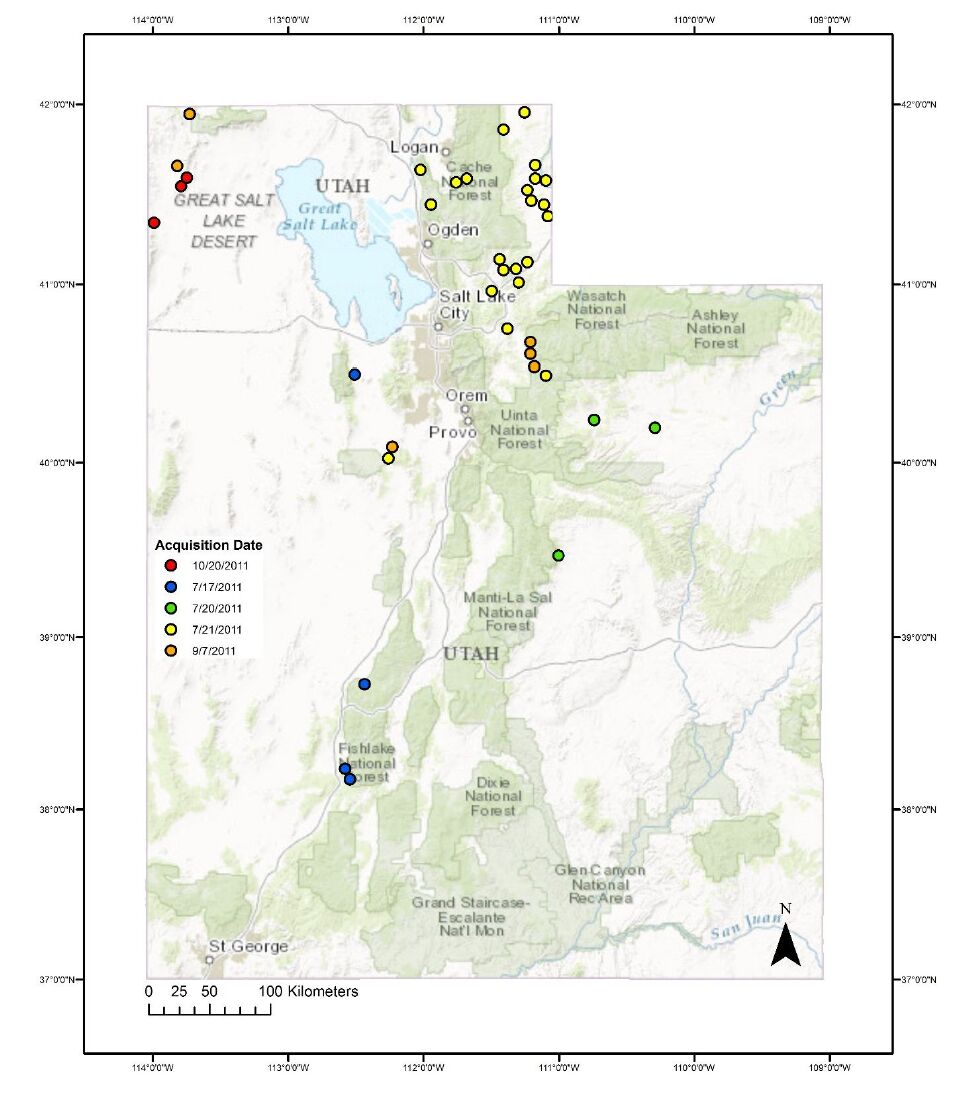
 DownLoad:
DownLoad: 
